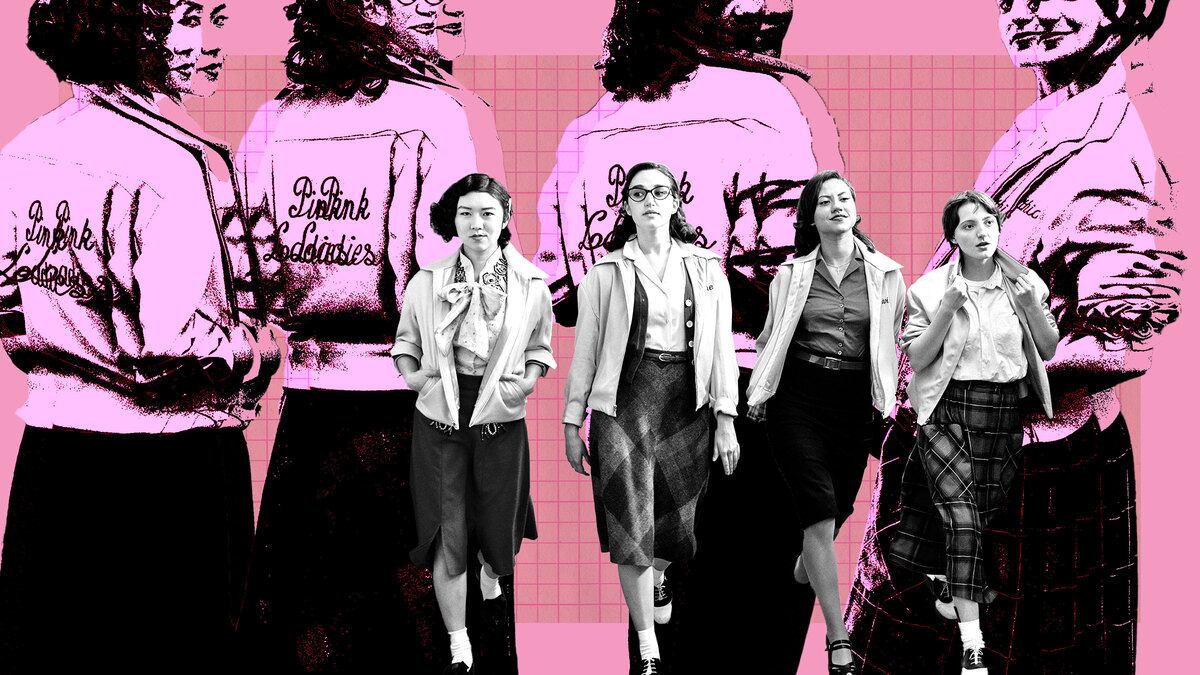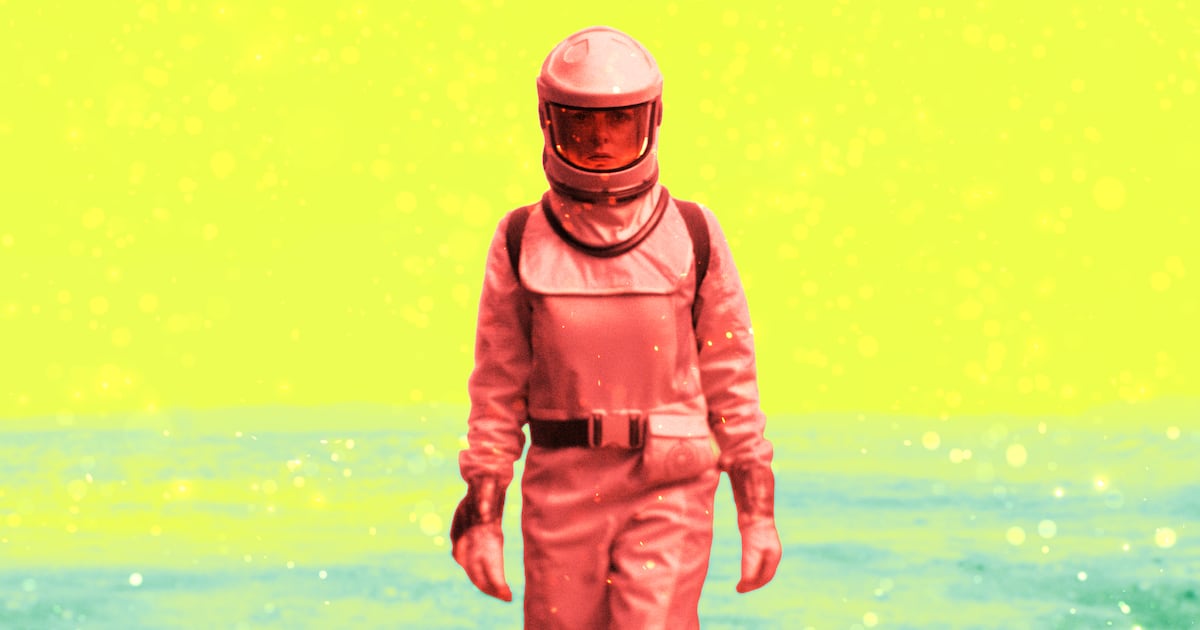When plans for a Grease prequel series were first announced, TV writer and showrunner Annabel Oakes had the same reaction that, at least anecdotally, the rest of the world had: “Grease? No! Grease is perfect.”
It’s interesting, then, that Oakes would go on to be the creator and showrunner of that very series, Grease: Rise of the Pink Ladies, which premieres Thursday on Paramount+. The musical series—yes, there are original tunes, and yes, classics from the musical and movie return as well—is an origin story of the girl gang, set in the early 1950s, before Rizzo, Frenchy, Jan, and Marty ruled Rydell High.
In the same way that Grease was a rabble-rousing commentary on gender roles made in the ’70s but set in the ’50s, Rise of the Pink Ladies broadens that provocation to include sexual orientation, gender expression, and racial identity.
Here, a group of outcasts, who rebel against the prescribed rules for how and where they’re supposed to fit in, incite a moral panic. They forge a bond and eventually don the iconic carnation-hued jackets, learning to be unapologetic about who they are—whether that’s Nancy (Tricia Fukuhara), a Japanese-American aspiring fashion designer, or Cynthia (Ari Notartomaso), a tomboy desperate to join the T-Birds but repeatedly shunned by her heroes.

How did Oakes go from finding the idea of the series blasphemous to being in charge of the whole ambitious endeavor—and even coming up with that premise? It involves a baby born on a bathroom floor, bad traffic, and an exhausting amount of research. It also helps that she’s as huge of a Grease fan as there comes.
“I have a picture of me when I’m 10 years old dressed as Patty Simcox for a dance performance my dance school did of ‘Greased Lightning,’” Oakes tells The Daily Beast’s Obsessed of her lifelong fandom.
“I performed ‘Greased Lightning’ at several local malls and parking lots and nursing homes,” she says, laughing. “It really spoke to me. My favorite part of Grease was that ‘Look at Me, I’m Sandra Dee’ sleepover, with those girls being naughty and bawdy—making fun of each other and doing kind-of grown up things, but still kind-of teenage things. There’s stuffed animals still on the bed, but they’re writing to soldiers. I just thought that was the greatest, and I wanted to live in that world.”
Little did she know the extent to which she one day would.
With Grease: Rise of the Pink Ladies now available to stream, we spoke to Oakes about the Herculean task of creating a new Grease story while protecting the original’s legacy, what inspired her take on the Pink Ladies, and what she hopes Grease’s biggest fans will take away from the series.
Like you, I remember watching Grease constantly growing up. At one point, when I was 9 or 10, the VHS tape disappeared. It turned out that my mother had started to hide it, because I was getting to the age where I would understand the jokes.
Right. The racy stuff. I know. Its like, for years of my life, I didn’t understand what “false alarm” and “25-cent insurance policy” meant—all those things that were very coded. And so that’s why I like watching Grease over and over again. It’s such a textured movie. I’ve watched it many times now without the sound, just to take in production design and directing. You’ll just see these background dancers, who are distinct characters, who have these relationships with each other. And you’ll just see the weirdest little moments. I always talk about Rizzo coming out of the bathroom with an ice cream cone.
Oh my God. Yes. I never clocked how absurd that is!
It’s so beautiful. You’re like, “Why is she coming out of the bathroom with an ice cream cone?” And just the beautiful tableaus they all make. Everybody’s busting in on Danny and Sandy’s date, and they’re all crowded around, and their limbs are everywhere, and they’re all doing something different. It’s just a really beautiful ensemble piece.

When this prequel series came about, did it seem like a fun challenge? Or did it seem outrageous at face value, like so many people thought?
All I knew is the studio wanted to do some sort of reboot of Grease, and I was not on board. The email, I remember I was visiting friends in D.C. when I got the email. I said, “Grease? No! Grease is perfect.” And I really meant it. Like, I did not want any part of this. I was like, “What a sick, sad money-grab from a major studio exploiting their IP.” I could not have been more [motivated to be] typing on Deadline, "Does Hollywood have no new ideas?”. I went 100 percent there.
I think that’s how most people felt.
Then a very weird thing happened, where my cousin’s wife gave birth to her second child on the floor of their bathroom. I happened to be in D.C., where they lived. So I got the email about [the show], and literally as I was writing back to the executive saying [the white lie of], “No, thank you, my plate’s a little full,” I stopped. I was going to go to the hospital and meet the baby, because I happened to be in town. I ended up in a 45-minute cab ride on the D.C. Beltway. I just was like, “Well, let me think about it for one minute. Like what? What unanswered questions do I have about Grease?”
Because of traffic, you had the time to think it over.
I started thinking about the Pink Ladies. Were they real? Or was that just kind of an invention? I did a quick Google. I found out the Pink Ladies were real. They were a small gang of tough girls at Taft High School, where Jim Jacobs, the creator of Grease, the stage musical, went to high school. I just wanted to know more about them and what it was like to be a teenage girl in the 1950s.
I called my mom, who went to high school in the 1960s and asked her what her experience was like. What was similar to Grease? What was different from Grease? And I started calling her friends, who went to high school in the ’50s. And then I got into digging up Southern California high school yearbooks. Like, what did a high school actually look like in Southern California in 1954? [Paramount+] didn’t have the Pink Ladies part of it. I was the person who brought the pitch to focus on the Pink Ladies and explore the Grease universe through that lens.
We all have Frenchy, Rizzo, Jan, and Marty in our minds as the Pink Ladies. When you’re creating this show and you have four Pink Ladies again, how do you make it so it doesn’t just seem like we’re watching a pale attempt at the four characters that we all knew from the movie?
I think the recipe was you take a little bit from Grease, you take a little bit from research, and you take a little bit from inside my brain and my experiences. That’s how each of them came together. I was like, What would our version of a Frenchy be? Telling the story of the school that we wanted to tell, she would have secret dreams of becoming a fashion designer. I also researched people who were fashion designers in the ’50s.

At this high school that is near me in Southern California, there was a huge Japanese-American population. I literally got the yearbook and was looking through it and wondered what their lives are like. I cold-called some people from that yearbook, and so that was how the Nancy character became Japanese American. And the Grease piece of it is [that] she was kind of like the Frenchy. Frenchy was the person who focused on her career. But she was a little quirky and 10-percent off-center and had this beautiful energy. I wanted to bring all those things together to make kind of like what is our version of a Frenchie, that is not a sad carbon copy of Didi Conn.
The major set pieces from the movie are indelible, like “Greased Lightning,” the school dance, or the slumber party. How do you feel about the fact that when there’s a dance in the auto shop in the series, people are going to immediately think, “This is the show’s version of ‘Greased Lightning?’” Or when there’s a slumber-party song, people will say, “Oh, this is their ‘Look at Me, I’m Sandra Dee?’”
I think when you’re doing a prequel to something, you do want to service the nostalgia of the piece. That's why [the lyric] “Grease is the word” is the first thing that you hear [in the show]. You want to hold the viewer's hand and say, “It's OK. This is still Grease. It’s going to be a little different. But we here love Grease. We’re not saying Grease was bad. We love Grease and want to expand the spirit of Grease.” So we do have a lot of those set pieces. We have a dance in an auto shop, but it’s from a different lens than it was in Grease. Not that it was a bad lens. Grease was an amazing lens. Grease was a commentary on what was happening in the ’70s, set in the ’50s. And we’re doing the same thing, but in the 2020s.
How did you think about modernizing and infusing this ’50s-set story with some of the concerns that we have in 2023?
The most important thing is that all of these people existed in the 1950s. They were there—they were just off-camera in a Technicolor musical. So we're just shifting the lens to put them on-camera. We really took what they did in the Grease film, which was approaching the ’50s from a ’70s lens. The ’70s was very concerned with people busting out of their gender roles, and there was some anxiety and moral panic in this society about that. I think that'’s where the comedy of Grease comes from.

That is the comedy of “Summer Nights” and the comedy of even “Look at Me, I’m Sandra Dee.” It's about a girl being stuck between a prude, like Sandy, or a slut, like Rizzo. I think that we are just expanding the spirit of Grease. Grease was doing that about gender roles. We have a lot more time to tell stories. We have more characters whose stories we can tell. So we wanted to extend that to other issues of identity, of sexual orientation, of gender expression, of racial identity. And I think if Grease had time, [the movie] would do that too. But that’s just the benefit we have, as a TV show.
Keep obsessing! Sign up for the Daily Beast’s Obsessed newsletter and follow us on Facebook, Twitter, Instagram and TikTok.






